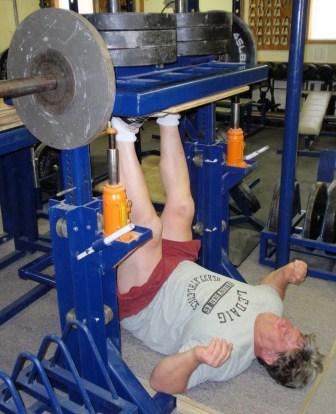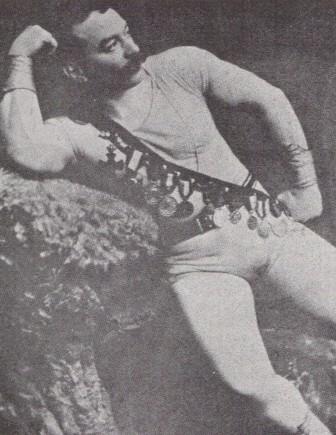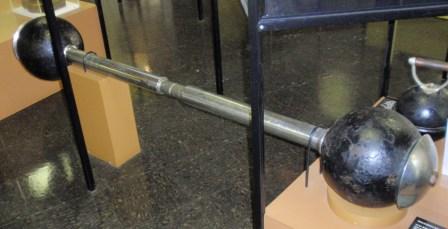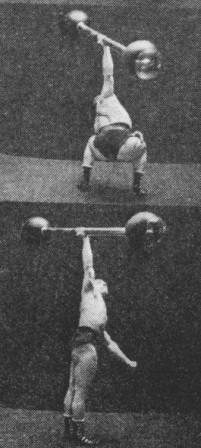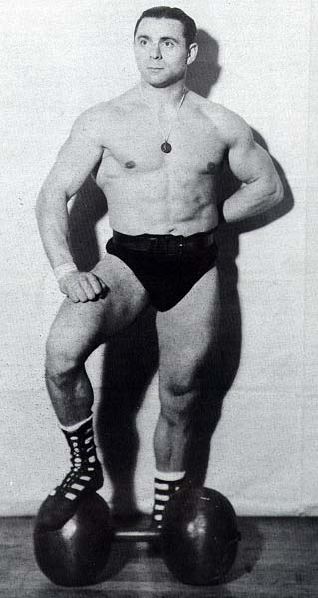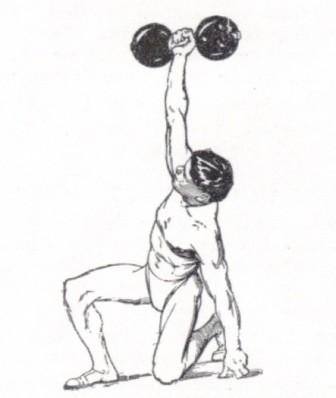The Foot Press
by Al Myers
Recently at the Dino Gym Challenge we performed an “exhibition lift” that was a very popular Old Time Strongman performance feat. I initially termed it the “Plank Support”, but the proper name for the lift we did in the meet should be the “Foot Press”. This lift has never been contested before (in modern times at least) so I had some uncertainty in how the event would go. The difference between a Plank Support and a Foot Press is this – in the Plank Support the legs are already locked as weight is added to the feet while with the Foot Press the weight is pushed up with the legs/hip to lockout. Both of these were favorites of Arthur Saxon, and it is reported that he did 3200# in both. Saxon would lay on his back while a heavy plank was placed on his feet in which weight (often in the form of people) was loaded onto the plank. He did “a little extra” with his act in that once the weight was loaded and supported he would slightly unlock his knees and then leg press it out again. So in a sense he was doing both a Plank Support and Foot Press at the same time! Other strongman didn’t unlock their legs when doing this stunt. He also didn’t use any hand supports, thus maintaining balance with his feet only! The rules for the Foot Press as was done at the Dino Gym Challenge is as follows:
Rules for Foot Press
An apparatus is used in which weight is loaded onto the feet only while the lifter is laying on his/her back on the floor/platform with the legs vertical and perpendicular to the floor. The apparatus used must allow the weight to rise without providing any leverage to the lift, but may be guided in a tract. It is also acceptable to use a plank resting on support platforms. The lift starts at the lifter’s discretion. Hands may be placed on the legs or any part of the apparatus, but must not be used to push directly against the weight being lifted. The weight lifted must clear the supports and be held motionless, at which time an official will give a command to end the lift.
The following is a story told and written by Sig Klein, “When Arthur Saxon came to this country to fill an engagement with the Ringling Brothers Circus, weightlifters in and around New York thought here was the athlete for Warren Lincoln Travis to meet in competition. For reasons never made clear to me, this match never materialized, although Travis trained for the match that was being talked about. He told me that he could never hope to equal Saxon in the Bent Press or on the Foot Press, but he trained on these lifts nonetheless. Travis spoke to Saxon about the Foot Press and I will tell you what transpired regarding this lift. Travis asked Saxon if a contest was to be arranged and the Foot Press was one of the tests, if he, Saxon, would agree to allow Travis to do his lift with the plank resting on two trestles and iron placed on the plank. Saxon, who had his two brothers trained and a group of men who were placed on this plank in perfect order by the brothers, agreed to allow Travis to do anything that he desired. Travis said that this was the way Saxon acted about most any lift. He was very fair and would agree to most any kind of arrangements for a contest as long as Saxon could get a contest. Travis had the greatest respect for Arthur Saxon and told me that in an overhead weightlifting contest Saxon could beat him but that Travis hoped to defeat Saxon on the Back and Harness and Finger Lifts.”
I was very impressed with this lift and everyone at the meet seemed to enjoy it. It is a lift that can be done in almost any gym. All it takes is a Vertical Leg Press Machine or a Power Rack in which a plank could be placed across the supports. The Foot Press is the Heavy Lift version of the Leg Press. There are a couple of Leg Press Lifts as official USAWA lifts, but they are full range of motion lifts and nothing like the Foot Press. I am going to present this lift to the USAWA Executive Board for new lift approval so hopefully, the next time the Foot Press is done it can be “official” and records can be set in it.
